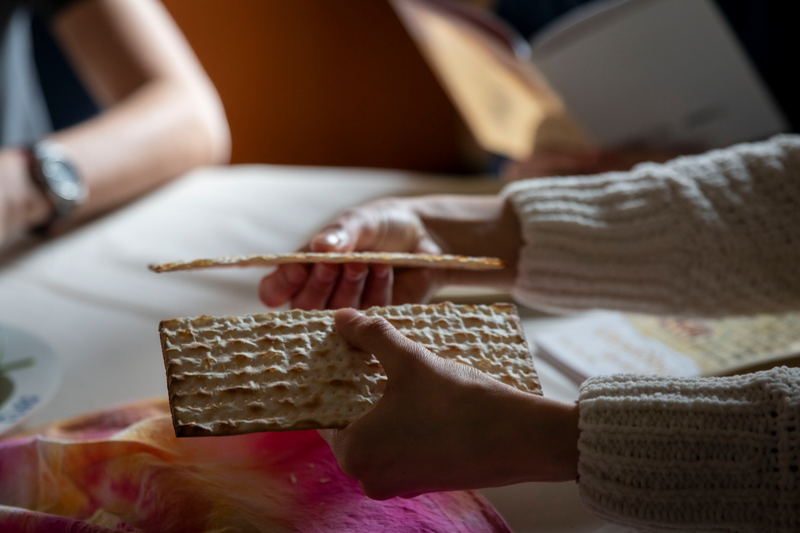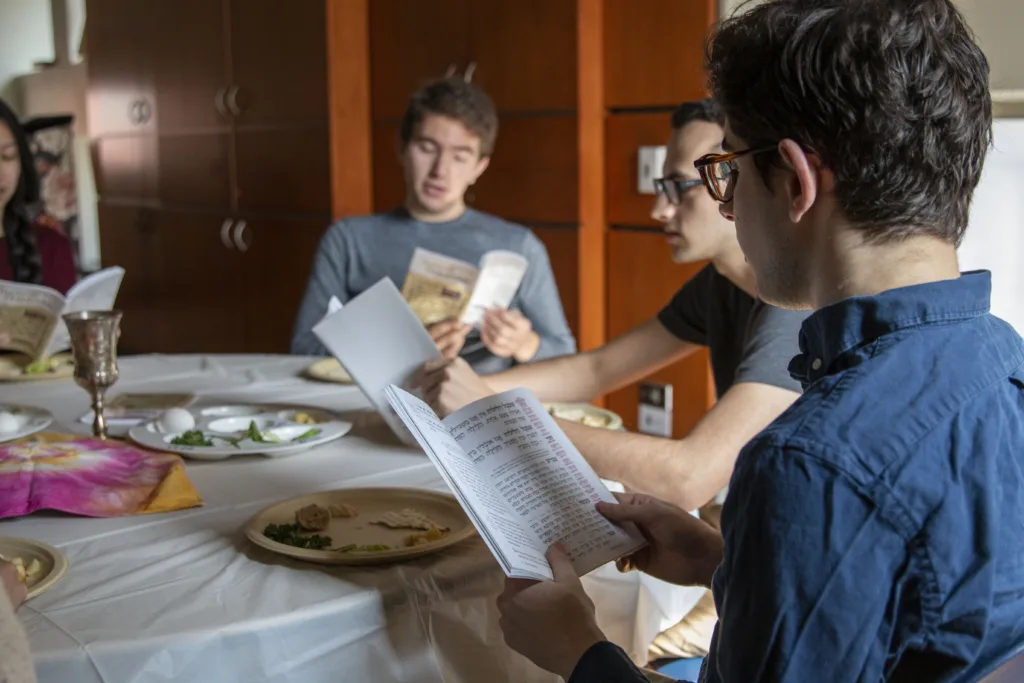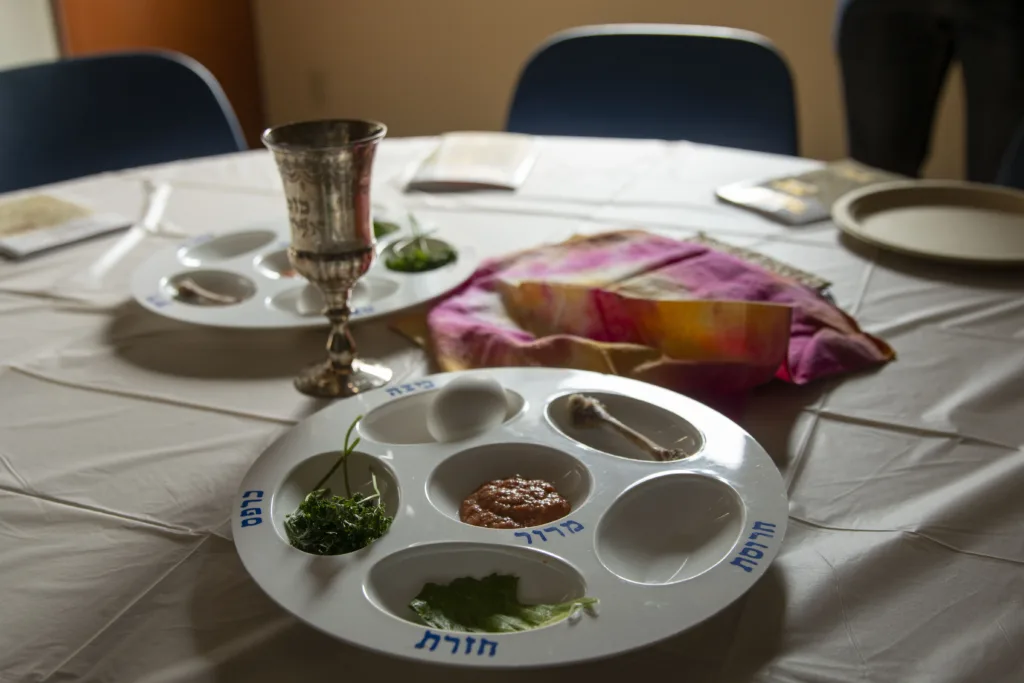WTSeder?! Everything You Ever Wanted to Know About Passover: Part One

First things first: What even IS a Seder?
Every year, Jewish people tell and retell the miraculous story of the enslaved Israelites’ exodus from Egypt during a festive meal called a Seder (Say-der). In Hebrew, the word Seder means order. A Seder is a structured, home-based ritual that combines a series of choreographed rituals with education, food, singing and storytelling, all in a particular order of stage directions. Intentionally designed to engage people of all ages, Seders are held on the first and second night of Passover (this year on April 22 and 23!).
With delicious food and drink, a good story, and deep conversation, it’s no wonder Passover is the most widely celebrated Jewish holiday in the world! Read on to learn more about the ritual, what you may want to put on the table – and a cheat sheet with directions on organizing your Passover Seder!
WTHaggadah?!
Over time, the Passover ritual was expanded and eventually written down in what we call the haggadah (hah-gah-dah), the book of Passover Seder choreography we still use today! The Hebrew word haggadah means “the telling,” which is an appropriate name for a script that tells the Passover story.
While virtually every haggadah follows the same order, there are many ways to tell the same story and just as many points of view. That is why there are literally hundreds of different hagaddot (plural form of haggadah). It can be overwhelming, but it also means you can find a version that suits you.

Some holy bites:
The Seder plate is a visual representation of the Israelites’ enslavement and liberation from Egypt. It has special spaces to hold symbolic foods that each tell different parts of the Passover story.
Maror (bitter herbs): Representing the bitterness of slavery, Maror is an uncomfortably bitter and sometimes spicy herb or vegetable. Horseradish is commonly used, but fresh radishes, spicy peppers, and even wasabi can be used too.
Zaroa (shank bone): This is symbolic of the biblical spring sacrifice of a young lamb called Pesach (Pay-sakh). People substitute other bones (e.g. a chicken neck or a leg) and vegetarians use a red beet or a sweet potato.
Beitza (roasted egg): Another spring symbol, representing the renewal of life. It also marks the birth of Israelites as a free people. Roasting recalls the ancient sacrificial practices in Jerusalem.
Chazeret (bitter greens): Romaine lettuce, endives, or chicory are used as a second symbol of bitterness sometimes used when making a sandwich with matzo.
Charoset (mortar): This fruit and nut mix may taste sweet, but its name is derived from the Hebrew word for clay. Charoset represents the mortar used by pyramid-building enslaved Israelites.
Karpas (parsley): It can be any leafy green, but often is parsley. It is symbolic of the rebirth of spring and the flourishing of the Israelites prior to their enslavement in Egypt. It is dipped into saltwater or vinegar to remember the freshness of freedom and the sting of tears from oppression.

Why is this plate different?
As we retell the Passover story, we are encouraged to interpret traditions and to find relevance in the time in which we live. One way of doing that is to connect contemporary events to the themes of Passover by placing new symbols on the Seder plate. Here are a few examples of contemporary symbolic foods you may see on seder plates – you are invited to take inspiration and add symbols with personal resonance for you as well! Note that many Jewish communities are finding ways to acknowledge both October 7 and the more than 130 hostages still being held in captivity. For example, Rabbi Elie Kaunfer suggested placing less matzo at the table to signal the absence of the hostages. Other ideas included putting empty seats representing October 7 victims, hostages, and soldiers around the table, and even rethinking the haggadah text.
An orange: One of the first historically-recorded Seder plate innovations, it has become a way to honor those who have been excluded from the Jewish community, especially women and LGBTQ people. This symbol has also evolved to be a symbol of including women in the rabbinate.
Ruth’s mix: Almonds, raisins and chocolate: Honoring Ruth, who married and/or converted into the Jewish people, this mix acknowledges that the Jewish community is sweeter by the presence and celebration of all Jews, Jews by choice, interfaith families, and our cherished allies.
An olive: The olive branch has been a symbol of peace since the time of Noah. Some people place an olive on the Seder plate in hopes of a time when Israelis and Palestinians live together in peace.
A tomato: In solidarity with migrant farmworkers, some add a tomato to symbolize support for an end to modern-day slavery in our fields and a call for fair wages and safe working conditions.
An acorn: Some Jews include an acorn as a way to uplift indigenous land acknowledgments at our seders. It is a reminder to understand the oppression that occurred in the locations where we live/work/learn, a call to repair, and a recognition that modern-day comforts sometimes lie on the foundations of historic suffering.
A lock and key: Representing the brokenness of our justice system, the lock and key are a literal reminder of how racial bias and unfair practices in our legal system have resulted in mass incarceration.
Aside from the Seder plate, there are several more ritual objects on the festive Passover table:
Wine or juice: Four cups per person, to be exact. Each cup marks a different transition in the Seder.
Kiddush cup: Used to make blessings over the wine.
Nerot/candles: We sanctify the holiday by lighting festival candles and saying a special blessing.
Afikomen/hidden dessert: The middle matzo is split in two and the larger half is hidden. At the end of the meal, children (of all ages) are invited to search for it and retrieve it for a prize. Traditionally the Seder cannot resume until the Afikomen is returned and eaten – all before midnight!
Seder plate: Contains all the ritual foods used throughout the Seder
Elijah’s (empty) chair and cup of wine or juice: The prophet Elijah is attributed to bringing about the World to Come, a time of redemption and liberation for all. This spirit of hope is invited to join the Seder as we open the door to figuratively “welcome” Elijah. Elijah also gets his very own cup of wine or juice, creatively called “Elijah’s cup.”
Matzo/unleavened bread: Often the star of the evening, matzo has its own special plate or tray where three pieces of matzo are stacked. The middle matzo is broken and the larger piece (the afikomen) gets hidden somewhere in the house to be found later. Matzo is a symbol of both oppression (the bread of the poor) and liberation (the bread the Israelites ate as they escaped from Egypt to freedom).
Miriam’s cup: Miriam, the prophetess, is associated with water because she watched over her baby brother, Moses, as he floated down the Nile, led the women during the parting of the sea, and according to Jewish legend, she became the bearer of a well that nourished and healed the Israelites on their wilderness journey. It has become a modern ritual to place a cup of water on the Seder table in her honor.
Your Seder cheat sheet: All the Passover choreography and stage directions in one place!
- Kadesh: We begin with a blessing over a cup of wine (or grape juice) to sanctify the holy day! Pace yourself, there will be a total of 4! L’chaim
- Ur’chatz: A ritual hand-washing without the blessing. Sometimes the leader does this symbolically for everyone. It feels good to start the seder fresh.
- Karpas: In honor of springtime and the freshness of freedom, we take a green vegetable or herb (commonly parsley), offer a blessing, and eat. Remember, friends do not let friends speak with greens caught in their teeth!
- Yachatz: Called “The Bread of Affliction,” we hold up the three matzot for this part of the ritual. The leader breaks the middle matzo and places the larger half aside for the afikomen, the piece of matzo that is hidden and eaten as “dessert.”
- Maggid: This section means “the telling” and is the main event! We begin to tell the story of the Exodus, learn about the rituals of Passover, and have conversations at the table. It is a time for questions, including the famed Four Questions, sometimes sung by the youngest person at the table. Alongside the traditional components, this is often where people bring creativity by acting out plays or trying some communal storytelling. Some even use props to help bring the teachings to life and make the Seder memorable. The second cup of wine is also blessed during this section.
- Rachtzah: This is a second hand washing, with a blessing, before the ritual eating of the matzo.
- Motzi and matzo: If one blessing is good, two is better. We bless and eat the matzo, first with the blessing for all types of bread and then a special blessing just for matzo.
- Maror: The bitter herbs remind us of the suffering of the Israelites’ enslavement. We say a blessing as we eat it, some choose to dip the bitter herbs in the sweet tasting charoset.
- Shulchan orech: Dinner time!
- Korech (Hillel’s sandwich. Shoutout to Hillel, the ancient sage our entire movement is named after!): One of the many things Hillel was known for was taking what he thought were the three most important symbols, the lamb, the bitter herbs, and the matzo, and combining them into a Pesach sandwich! With no lamb, we add the bitter herbs (some use the green bitter herb, Hazeret), haroset and matzo. Consider it the first appetizer!
- Tzafun: The Afikomen (which reappears from Yachatz) must be eaten for the Seder to continue. With no sacrifices, ritually eating it represents the Pesach sacrifice. Often hidden, children (of all ages) search it out and receive a prize for its return. A small piece is eaten and the seder continues. The Seder is almost over.
- Barech: We offer a blessing for the festival meal and drink a third cup of wine. Open the door for the prophet Elijah and welcome in the spirit of Miriam.
- Hallel: This section includes many traditional psalms that are sung, and some contemporary Jews add and/or exchange modern songs about freedom and liberation (Bob Marley anyone?). The last cup of wine is also blessed during this section.
- Nirtzah: Hopefully when you reach this point, you will have enjoyed good friends, good conversation, and good food! We typically conclude with the words, ”L’shana haba’a b’Y’rushalayim!” meaning “Next year in Jerusalem!”
In part two of this series, we’ll explore the origins of Passover!